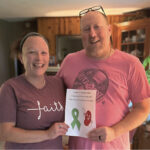A 71-year-old man notices a severe, sharp pain starting in the middle of his back that spreads in a narrow band down to his belly. The pain is limited to one side of his body. The pain is “one of the worst pains I have ever experienced.” A couple of days later, he notices an outbreak of fluid filled blisters in the same area. The lesions heal over the next week, but leave some scaring. The area stays extremely painful and he requires high dose narcotics for control. After about three months, the pain begins to get better but does not fully subside for a full year.
The above patient has herpes – zoster; an often painful reactivation of the varicella-zoster virus (the virus which causes chicken pox) which most commonly occurs later in life. After the initial infection, the varicella-zoster virus persists in the sensory nerves of the spine. A healthy immune system will limit the virus to the spine where it is does not cause any symptoms.
However, if the immune system is weakened, the virus can reactivate, spread up the nerve to the skin, and cause the recurrence of the chickenpox on the area of the skin enervated by the spinal nerve. The virus damages the nerves it infects and often results in a severe neuropathic pain that can last for months or even years. The pain can be prolonged, severe, disabling, and often requires long term narcotics for control. The resultant decline in quality of life and ability to function is equivalent to being afflicted with a major medical illness such as congestive heart failure, a heart attack, or depression.
Almost all adult Americans have been exposed to the varicella virus and are at risk of developing zoster. Approximately one third will actually develop zoster at some point in their lives. The immune system often weakens as you age. Consequently more than half of the cases of zoster occur in people over the age of 60 and approximately one-third of these older patients will develop post-herpetic neuralgia, the often severe pain described above. Fortunately, there is now a vaccine that can prevent zoster.
The zoster vaccine (Zostavax) is a live attenuated vaccine. It consists of a live version of the varicella-zoster virus which has been weakened so that it is unlikely to cause disease but is still able to stimulate the immune system. In clinical trials, the vaccine decreased the incidence of zoster by about by 51 percent and post-herpetic neuralgia by 67 percent. In patients who had developed zoster, the pain duration was slightly shorter and its severity less.
The only common side effects of the vaccine were pain, swelling, and redness at the injection site, which had occurred about one-third of the time. A chicken pox like rash can also occur at the injection site. However, this occurs in less than one out of 100 patients.
The vaccine is available for anyone above age 60. However, because it is a live vaccine, it should not be given to people who have a compromised immune system including with those with HIV, undergoing chemotherapy, or on chronic steroids.
I routinely recommend the Zostavax vaccine to my patients above the age of 60. The vaccine is very effective, very safe, has few side effects, and has the potential to keep them from developing a disease that has the potential to cause severe, prolonged, and debilitating pain.





